Key Takeaways
- There are two broad categories of muscle fiber types: fast- and slow-twitch muscle fibers.
- There’s no easy or reliable way to test your muscle fiber type, you can’t significantly change your muscle fiber type, and there’s little evidence you should train according to your muscle fiber type.
- The good news, though, is that you can build muscle and strength regardless of your muscle fiber type. It just doesn’t matter that much for getting big and strong.
You’ve probably known this since sixth grade:
Muscles are made of different muscle fiber types.
You also know that different muscle fibers have different properties. Some are better for endurance sports, like running, and others are better for speed and power sports, like sprinting.
If you’re a little more well read on this topic, you may also know that some muscle fibers grow larger in response to strength training than others.
That leads us to today’s topic:
Some say that you can “crack the code” of muscle growth by following a training plan that’s suited to your unique muscle fiber type.
According to the proponents, you can test your muscle fiber type and, once armed with that knowledge, target each muscle group with just the right rep range to spur muscle growth to new heights.
This new approach to training leaves your humdrum bodybuilding plan in the dust, they say.
What’s more, this strategy seems to be backed by good science.
If you’re like me, it’s hard not to feel like this:

The whole idea certainly has my attention.
Others go so far as to say that with the right kind of training, you can change your muscle fiber type to one that’s more advantageous for building muscle and strength.
Is any of this true, though?
Or is it just more bootless cajolery conjured up by Internet hucksters to separate themselves from the herd?
Well, you’re going to learn the answer in this article.
The long and short of it is that muscle fiber type does matter for sports performance, but it’s far less important for building muscle and strength.
You can’t accurately figure out your muscle type at home, and most of the recommendations for how you should train certain muscle fibers are half-baked at best and scientifically bankrupt at worst.
For any of this to make sense, you first need to learn what muscle fiber types are and what makes them different.
Let’s get started.
What Are the Muscle Fiber Types?
A muscle fiber is the same thing as a muscle cell, also known as a myocyte.
Under a microscope, these look like small red or white threads:
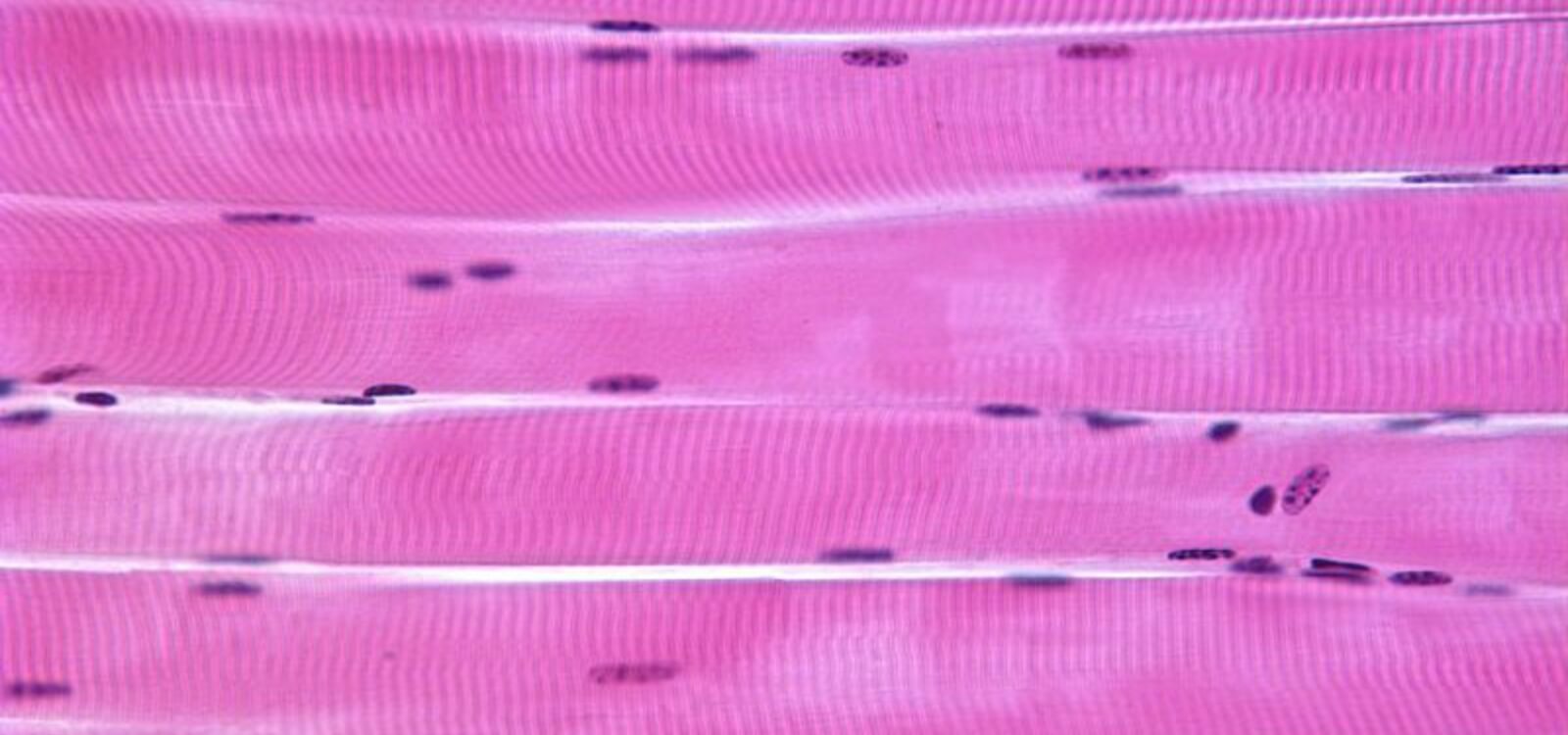
The horizontal pink lines are the muscle fibers.
Like thread, when these muscle fibers are wound together in bundles they form progressively larger units along with nerves, blood vessels, and various forms of connective tissue, to form a muscle.
Here’s what it all looks like under the hood:
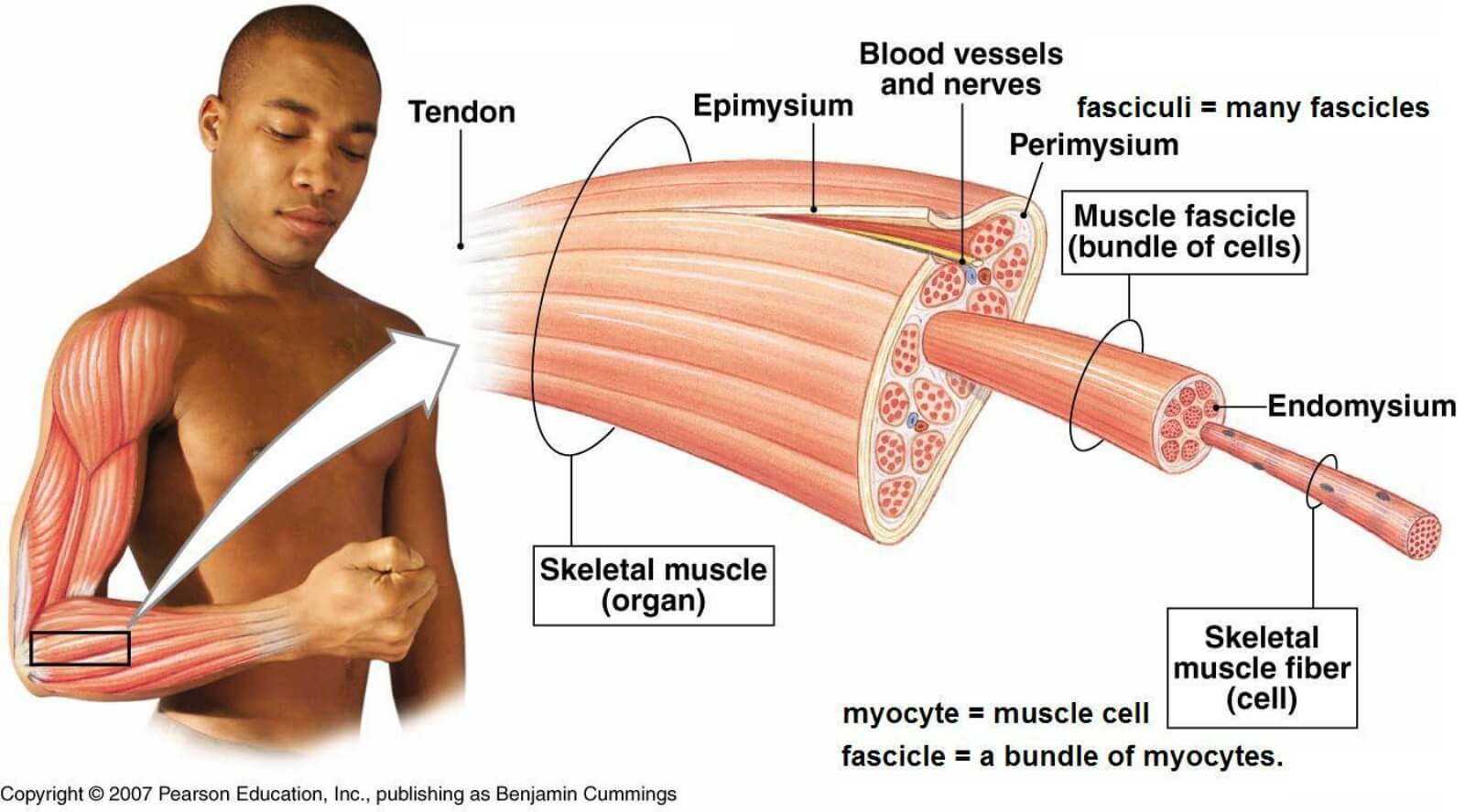
Not all muscle fibers are the same, but how much they differ and in what ways is still somewhat unclear.
Let’s try to sort it out, though.
The Muscle Fiber Types
Generally speaking, muscle fibers are lumped into two categories:
- Fast twitch
- Slow twitch
Although many people only think in these black and white terms, it’s better to think of these as two opposite ends of the same spectrum, with some fibers in the middle.
Let’s go over the main differences.
1. Fast-twitch muscle fibers (type ll)
Fast-twitch muscle fibers, also known as type ll muscle fibers, contract faster (hence the name) and have about a 25 to 75% greater potential for muscle growth than type l fibers.
This is why they’re generally considered helpful for power sports like basketball, football, and sprinting.
Sure enough, elite power athletes tend to have a higher proportion of type ll fibers in their muscles.
The downside is that type ll fibers are easily fatigued, which means they can’t perform as many contractions before they become worn out. They also take a while to recover before they can function again at full bore.
The archetypal fast-twitch animal would be something like a Cheetah. It can go really fast, but only for a few seconds and for a few rounds before it’s bushed.
Fast-twitch muscle fibers are also sometimes called “white” muscle fibers, because they have fewer mitochondria. These little structures are what produce the majority of energy during longer duration exercise and are what give muscle cells their red appearance under a microscope.
There are also two kinds of type ll muscle fibers:
- Type llx
- Type lla
Type llx muscle fibers are what you could call the “pure” fast-twitch muscle fibers.
They contract extremely quickly, have the greatest potential for growth, become fatigued in short order, and take a long time to recover.
Type lla muscle fibers are somewhere between slow- and fast-twitch muscle fibers.
They contract moderately fast and have a decent potential for growth, but they don’t become fatigued as quickly or take as long to recover as type llx muscle fibers.
2. Slow-twitch muscle fibers (type l)
Slow-twitch muscle fibers, also known as type l muscle fibers, contract slower (again, hence the name) and have a lower potential for muscle growth.
The upside is that slow-twitch fibers are very resistant to fatigue, which means they can perform many, many contractions before they become fatigued. They also recover quickly even after hours of use.
This is why they’re considered helpful for endurance sports like running, cycling, and swimming.
Here’s what they look like under a microscope:
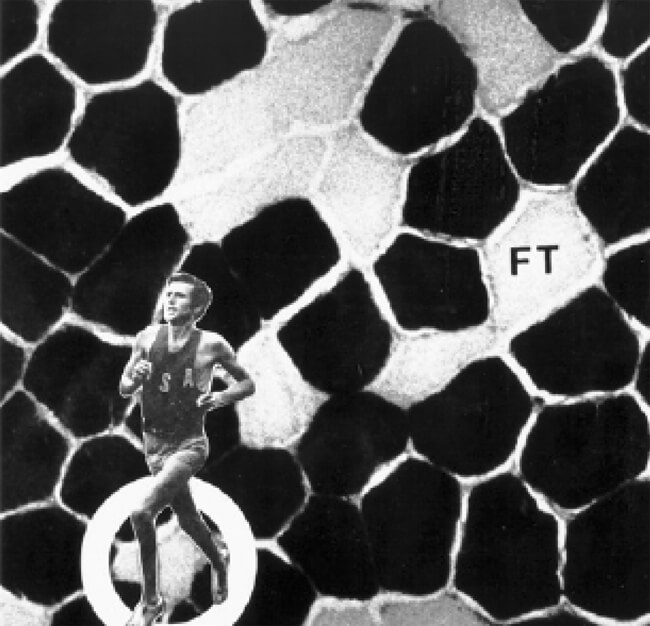
That’s a piece of muscle from the calf of the winner of the 1972 Olympic marathon, Frank Shorter. The black shapes are the slow-twitch fibers, and the white ones are the fast-twitch fibers.
The archetypal “slow-twitch” animal would be something like an elephant, which needs to constantly support a large body weight while stumping around for food, but isn’t great at sprinting.
Slow-twitch muscle fibers are also sometimes called “red” muscle fibers, because they have more mitochondria than fast-twitch muscle fibers, which gives them a red appearance under a microscope. Remember that mitochondria are the main “power plants” of muscle fibers, so it’s not surprising that the more resilient slow-twitch fibers have more of them.
Although muscle fibers are usually lumped into one of these two boxes, there’s another category: hybrid muscle fiber types.
These “hybrid” muscle fibers have both fast- and slow-twitch properties. They also seem to have a greater ability to become more fast- or slow-twitch in response to training (more on that in a moment).
The names and classifications for these different hybrid fiber types get complicated quickly, but the the main thing to keep in mind is that some muscle fibers are more fast-twitch, some more slow-twitch, and some are in the middle.
Okay, now that we have the basic physiology out of the way, let’s look at the question that’s probably on your mind: How do I know what my muscle fiber type is?
How Do You Know Your Muscle Fiber Type?
Peruse some articles online, and you’ll find many different home tests for determining your muscle fiber type.
For example, some people say that you have more fast-twitch muscle fiber if you:
- Can vertical jump at least 23 inches
- Can’t do more than 7 reps at 85% of your 1-rep max
- Require more rest between sets than most people
Others say you should just pay attention to what sports you’re good at. If you’re good at and/or enjoy running, cycling, and swimming, you must have slow-twitch muscles. If you’re good at and/or enjoy football, basketball, and sprinting, then you must have fast-twitch muscles.
This is more or less hokum.
Most muscles are split about 50/50 between fast- and slow-twitch muscle fibers.
Some people can have extreme amounts of fast- or slow-twitch muscle fiber, but the differences are smaller than you’d expect.
For example, researchers at Ball State University took muscle tissue samples of the world-record holder for the 60-meter hurdles in the 80s.They found that his quad muscles were 71% fast-twitch fiber. That’s a lot, but it also means that 29% of his muscle fibers were slow twitch, more than you might expect for a sprinter.
Elite endurance athletes tend to have the opposite makeup—about 60 to 80% of their muscle fibers are slow twitch, with the remaining 20 to 40% being fast twitch.
Those people are on the extremes, though. Most of us are going to be closer to the middle (which, as you’ll see, isn’t a disadvantage in most cases).
If we dig deeper, we see that individual muscles can have very different muscle fiber types.
The upper body muscles like the pecs, lats, biceps, and triceps tend to be slightly more fast twitch, while the lower body muscles like the glutes, hamstrings, quads, and calves tend to be slightly more slow twitch.
Here’s the breakdown for upper body muscles:
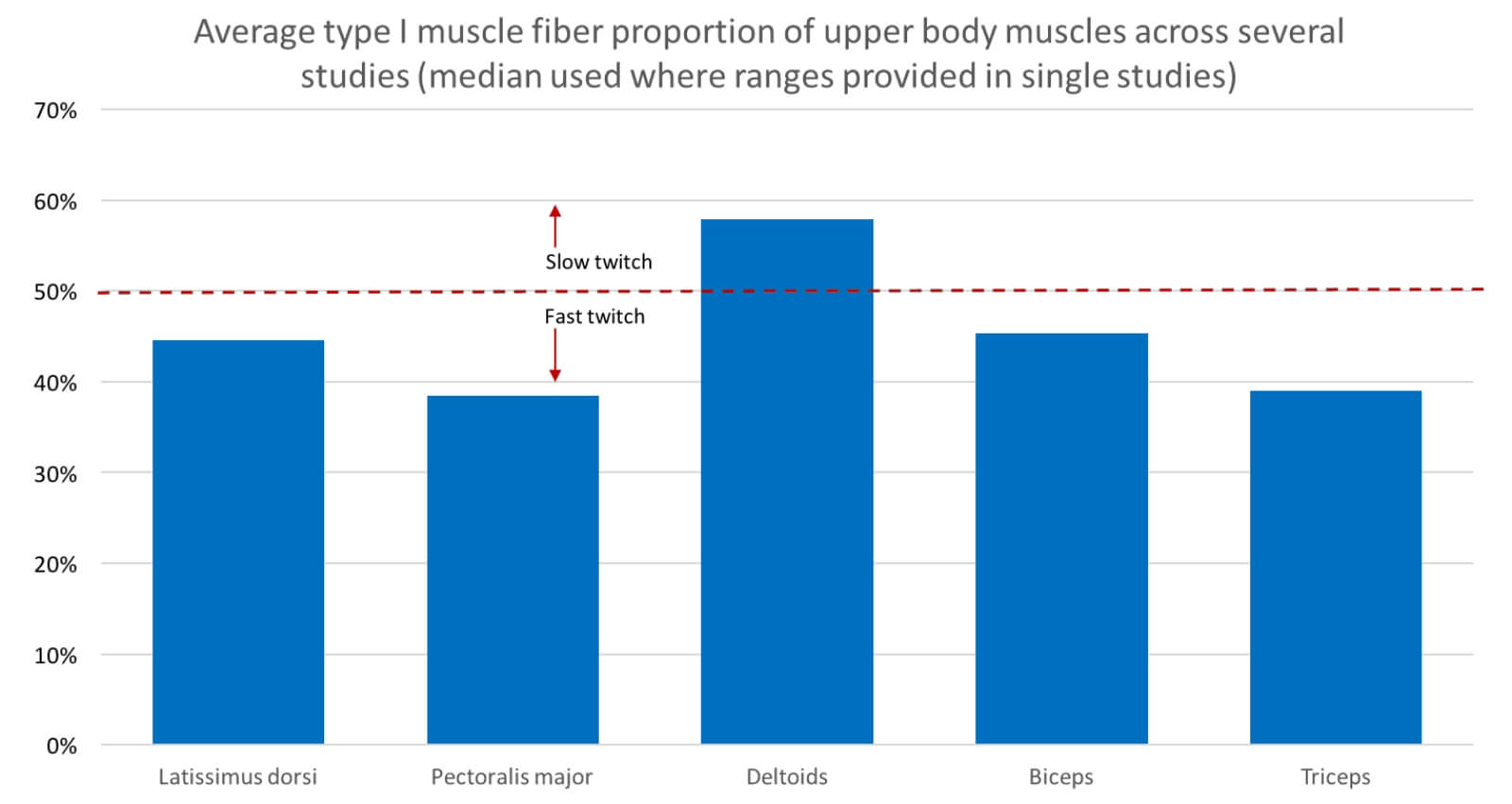
And here’s the breakdown for lower body muscles:
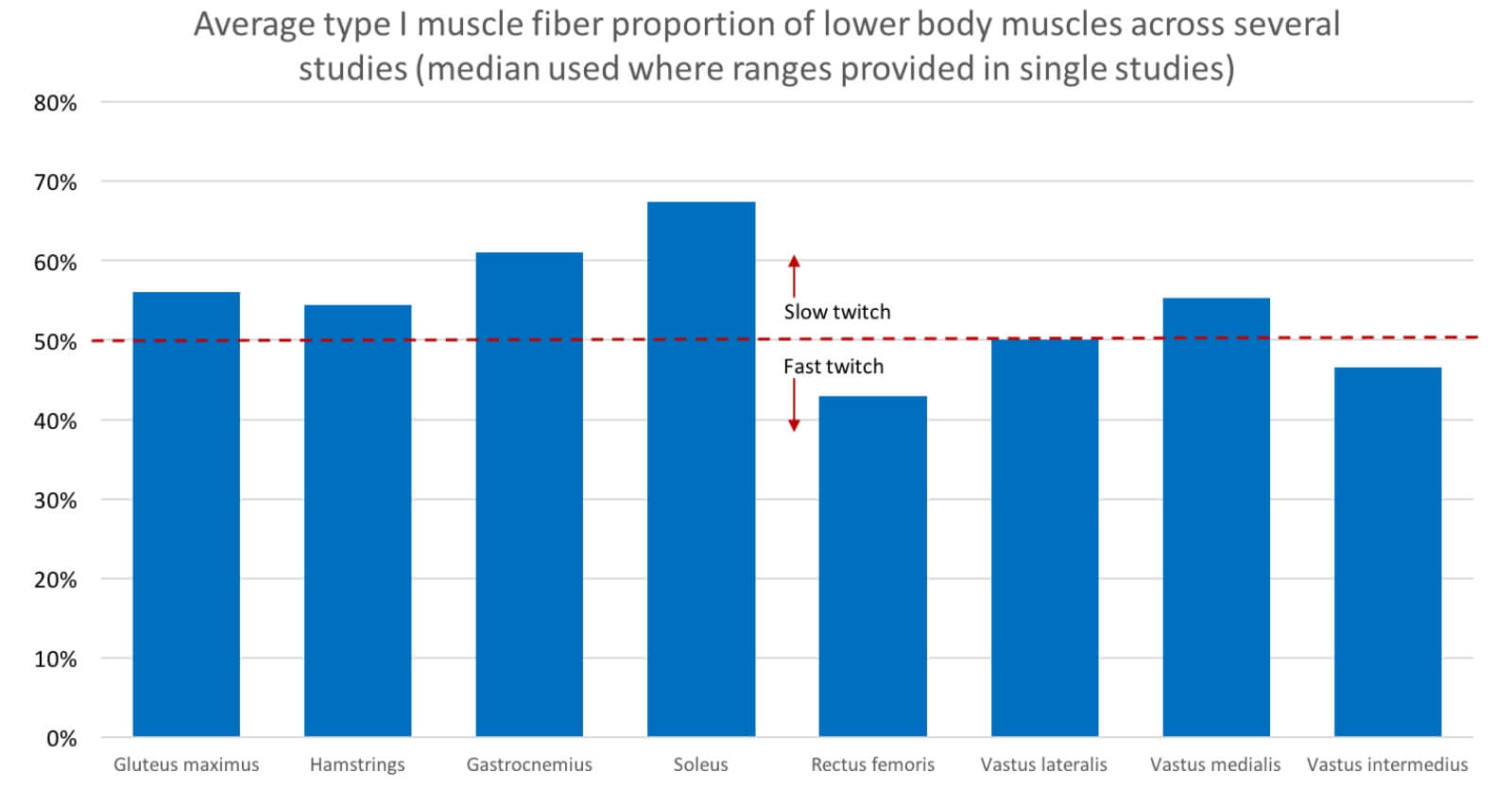
As you can see, most muscles are about 50/50. The only true outliers are the calves and the deltoids, which are closer to 60 to 70% slow-twitch.
In the final analysis, it’s very likely that your muscles are similar to these breakdowns.
Aside from cutting a small chunk out of your muscle and directly testing its fiber type, there’s no good way of determining your muscle fiber type. You’d also have to do that with every major muscle group in your body to get an accurate result.
Are you stuck this way, though, or can you change your muscle fiber type with the right training?
Can You Change Your Muscle Fiber Type?
Yes, but not as much as you might think.
Some people say that your muscle fiber type is entirely genetic and can’t be changed. Others prattle on about how you can shift your muscle fiber type to fast or slow twitch if you jump through the right hoops in your training.
Put in enough miles on the treadmill, you’re told, and you’ll turn more and more of your muscle fibers into slow-twitch fiber types.
Do enough sprints, jumps, and plyometrics, and you’ll build enough fast-twitch muscle fibers to jump like this kid:

Who’s right?
Well, the truth is somewhere in the middle, and there’s still a great deal of controversy among scientists about whether or not it’s possible to change muscle fiber type with training.
While they’re still unriddling the details, here’s what we can safely say:
It’s unlikely that you can turn your type l fibers into type ll or vice versa (although turning type ll into type l seems more plausible).
According to Scott Trappe, the director of the human performance lab at Ball State University, “With training, you could probably change your fiber type about 10 percent.”
This jives with the majority of research, which shows that even the most intense training programs cause small, slow shifts in fiber type over years.
Even then, most of the changes occur in those hybrid fibers we talked about earlier.
The pure fast- and slow-twitch fibers don’t seem to change much, if at all.
Considering that there are many other changes that take place within muscles in response to training, a 10 percent change in muscle fiber type isn’t going to make a significant difference in your strength, muscle gain, or performance.
You can make your existing muscle fibers become slightly more or less slow or fast twitch.
Some research shows you can make your existing type ll fibers slightly more fast twitch, and your existing type l fibers slightly more slow-twitch.
To do this, though, you generally have to train in a very specific way for a long time.
For example, if you focus most of your training on sprints, then you might be able to become a little more fast-twitch dominant. If you only run marathons for the next 10 years, you might become slightly more slow-twitch dominant.
On the other hand, most of the research tells a different story.
Most studies show that every kind of training, whether it’s sprints, weightlifting, or running, tends to cause your extremely fast-twitch type llx fibers to shift toward the slightly more slow-twitch type lla fibers. When you stop training, the changes reverse themselves.
Other research shows that powerlifters have about the same muscle fiber type breakdown as couch potatoes, which belies the idea that you can become more fast-twitch dominant by pumping iron and avoiding cardio.
On the surface, this seems worrying.
Does this mean that you’re damned no matter what you do? That no matter how hard you train, you’re going to get more slow-twitch (and thus, smaller) muscle fibers?
No, it just means that fiber type isn’t as important as many people say, and that having a bunch of fast-twitch muscle fibers isn’t really that important for getting big and strong.
Changes in muscle fiber type are overrated for building strength and size.
A common misconception is that strength training is a “power” sport, so having more fast-twitch muscle fibers means you’ll be able to lift more weight.
A second, related misconception is that because type ll muscle fibers can grow larger, people with more type ll muscle fibers will have a much easier time getting jacked.
While there’s a kernel of truth to both ideas, they’re more wrong than right.
First, “power” means generating as much strength as quickly as possible, but not necessarily the most absolute strength.
You see, slow-twitch muscle fibers are almost as strong as fast-twitch fibers, they just take a fraction of a second longer to kick into gear.
A typical rep of heavy barbell training is going to take a second or longer, which is plenty of time for both fast- and slow-twitch muscle fibers to pitch in.
Thus, even during your most intense sets, you’ll be using both fast- and slow-twitch muscle fibers.
When it comes to muscle growth, muscle fiber type is even less important.
It’s true that slow-twitch fibers don’t grow as much as fast-twitch fibers, but they can still grow enough to make a significant difference in your physique.
For example, researchers from Ohio State University found that both fast- and slow-twitch muscle fibers grew significantly after 20 weeks of strength training.
Recall that the major muscle groups in your body also have a roughly equal ratio of fast- to slow-twitch muscle fibers. Let’s say that, like most people, roughly half of your chest muscles are slow-twitch. Well, that’s still a lot of muscular real estate that, if well developed, is going to lead to much greater chest development.
Still not convinced?
Well, if having more fast-twitch muscle fibers was best for building strength and muscle, then you’d expect the strongest, biggest people to have the most fast-twitch fibers.
In reality, elite-level powerlifters have the same proportion of fast- and slow-twitch fibers as people who’ve never touched a heavy barbell.
Why?
Because when it comes to building muscle and strength, muscle fiber type just isn’t that important. Muscle fiber type still matters when it comes to pure speed and endurance, but it’s far less relevant if you just want to be big and strong.
Should You Train According to Your Muscle Fiber Type?

Alright, let’s get to the crux of the argument:
Will training according to your muscle fiber type help you build more muscle and strength?
To understand where this idea comes from, we need to look at how muscle fibers function during training.
When you perform an exercise, your body first activates the slow-twitch fibers, and then activates more of the fast-twitch fibers as you get closer to failure.
So, based on that logic, it seems like you’d want to do lots of light weight, high-rep training to target your slow-twitch fibers, and lots of heavy, low-rep training to target your fast-twitch fibers.
That is, if you’re training a muscle like the pecs that are slightly more fast-twitch, then you want to use heavier weights and lower reps to maximally target the majority of muscle fibers.
If you’re training a more slow-twitch muscle, like the calves, then you want to use lighter weights and higher reps to target the muscle fibers.
There are a few problems with this idea, though.
- As you get closer to failure, your body starts recruiting every kind of muscle fiber. That is, whether you use sets of 15 or 5, you could reach a similar level of overall muscle activation and muscle growth.
- Studies go back and forth on whether or not some muscle fibers respond better to low- or high-rep training. Some show that lower-rep, heavy training causes more fast-twitch muscle fiber growth. Some show that higher-rep, lighter training causes more slow-twitch muscle fiber growth. The best evidence, though, shows that both heavy training with 3 to 5 reps and lighter training with 9 to 11 reps works equally well for building both fast- and slow-twitch muscle fiber.
- As we already went over, most muscles are roughly an even split between fast- and slow-twitch muscle fibers. So, even if one style of training was able to target a specific muscle fiber type, you’d still want to do both high- and low-rep training to get the most muscle growth possible.
You don’t have to take my word for it, though.
One of the most comprehensive reviews on muscle growth to date, published in The Journal of Strength and Conditioning Research, concluded that “… a fiber-type prescription with respect to repetition range has not been borne out by research.”
In other words, there’s very little evidence that you should use certain rep ranges to target different muscle fibers.
At bottom, all of the normal rep ranges you’re likely to use cause a similar amount of muscle growth regardless of your muscle fiber type. Although slow-twitch muscles can’t get as big as fast-twitch, they can still contribute significantly to your overall size.
The best evidence shows that using some heavy, moderate, and light sets is the best way to build all muscle groups, instead of just sticking dogmatically to one rep range.
The Bottom Line on Muscle Fiber Type
With a few exceptions, the major muscle groups in your body have roughly an even split between slow- and fast-twitch muscle fiber.
There also isn’t much you can do to drastically change your muscle fiber type.
Years of consistent training can shift your muscle fiber type slightly, but it probably won’t add up to more than a 10% change in either direction.
Having more fast-twitch muscle fibers can be helpful if you need to sprint, jump, and throw things, and having more slow-twitch muscle fibers is likely helpful if you’re an endurance athlete.
If you just want to be big and strong, though, then muscle fiber type doesn’t matter that much.
Both slow- and fast-twitch muscle fibers grow significantly larger when you lift weights, regardless of what rep range you use, and there’s little evidence that training according to your muscle fiber type is better for building muscle.
The best way to build muscle is to use heavy, moderate, and light sets with a mix of low-, medium-, and high-reps, instead of just sticking to one rep range or intensity.
If you’re looking for exactly that kind of program, then you’re in luck. We just so happen to have one that’s based on all of the principles we went over in this article, and it includes everything you need to squeeze as much growth out of every muscle fiber type as you can. Check it out here:
What’s your take on muscle fiber types? Have anything else to share? Let me know in the comments below!
Scientific References +
- BJ, S., B, C., D, O., A, G., J, K., & GT, S. (2016). Effects of Varied Versus Constant Loading Zones on Muscular Adaptations in Trained Men. International Journal of Sports Medicine, 37(6), 442–447. https://doi.org/10.1055/S-0035-1569369
- BJ, S. (2010). The mechanisms of muscle hypertrophy and their application to resistance training. Journal of Strength and Conditioning Research, 24(10), 2857–2872. https://doi.org/10.1519/JSC.0B013E3181E840F3
- Morton, R. W., Oikawa, S. Y., Wavell, C. G., Mazara, N., McGlory, C., Quadrilatero, J., Baechler, B. L., Baker, S. K., & Phillips, S. M. (2016). Neither load nor systemic hormones determine resistance training-mediated hypertrophy or strength gains in resistance-trained young men. Journal of Applied Physiology, 121(1), 129–138. https://doi.org/10.1152/JAPPLPHYSIOL.00154.2016
- Mitchell, C. J., Churchward-Venne, T. A., West, D. W. D., Burd, N. A., Breen, L., Baker, S. K., & Phillips, S. M. (2012). Resistance exercise load does not determine training-mediated hypertrophic gains in young men. Journal of Applied Physiology, 113(1), 71. https://doi.org/10.1152/JAPPLPHYSIOL.00307.2012
- A I Netreba, D V Popov, E V Liubaeva, Ia R Bravyĭ, A B Prostova, Iu S Lemesheva, & O L Vinogradova. (n.d.). [Physiological effects of using the low intensity strength training without relaxation in single-joint and multi-joint movements] - PubMed. Retrieved September 10, 2021, from https://pubmed.ncbi.nlm.nih.gov/17465271/
- RW, M., SY, O., CG, W., N, M., C, M., J, Q., BL, B., SK, B., & SM, P. (2016). Neither load nor systemic hormones determine resistance training-mediated hypertrophy or strength gains in resistance-trained young men. Journal of Applied Physiology (Bethesda, Md. : 1985), 121(1), 129–138. https://doi.org/10.1152/JAPPLPHYSIOL.00154.2016
- Fry, A. C., Webber, J. M., Weiss, L. W., Harber, M. P., Vaczi, M., Pattison, N. A., Fry, A. C., Webber, J. M., Weiss, L. W., Harber, M. P., Vaczi, M., & Pattison, N. A. (2003). National Strength & Conditioning Association Muscle fiber characteristics of competitive power lifters. Journal of Strength and Conditioning Research, 17(2), 402–410.
- RS, S., ES, M., MJ, L., JE, F., FC, H., & GA, D. (1990). Muscle hypertrophy and fast fiber type conversions in heavy resistance-trained women. European Journal of Applied Physiology and Occupational Physiology, 60(1), 71–79. https://doi.org/10.1007/BF00572189
- W J Kraemer, S J Fleck, & W J Evans. (n.d.). Strength and power training: physiological mechanisms of adaptation - PubMed. Retrieved September 10, 2021, from https://pubmed.ncbi.nlm.nih.gov/8744256/
- Zierath, J. R., & Hawley, J. A. (2004). Skeletal Muscle Fiber Type: Influence on Contractile and Metabolic Properties. PLoS Biology, 2(10). https://doi.org/10.1371/JOURNAL.PBIO.0020348
- PE, E., GJ, M., RA, F., PC, W., MTG, P., & JP, F. (2017). The functional significance of hamstrings composition: is it really a “fast” muscle group? Scandinavian Journal of Medicine & Science in Sports, 27(11), 1181–1189. https://doi.org/10.1111/SMS.12786
- Andrew C Fry, Jesse M Webber, Lawrence W Weiss, Matthew P Harber, Mark Vaczi, & Nancy A Pattison. (n.d.). Muscle fiber characteristics of competitive power lifters - PubMed. Retrieved September 10, 2021, from https://pubmed.ncbi.nlm.nih.gov/12741885/
- JM, W., JP, L., E, J., GJ, W., MC, Z., & JS, K. (2012). The effects of endurance, strength, and power training on muscle fiber type shifting. Journal of Strength and Conditioning Research, 26(6), 1724–1729. https://doi.org/10.1519/JSC.0B013E318234EB6F
- DL, W., PM, G., CC, C., U, R., & SW, T. (2001). Reduction in hybrid single muscle fiber proportions with resistance training in humans. Journal of Applied Physiology (Bethesda, Md. : 1985), 91(5), 1955–1961. https://doi.org/10.1152/JAPPL.2001.91.5.1955
- E, J., B, S., & P, T. (1978). Changes in muscle fibre type distribution in man after physical training. A sign of fibre type transformation? Acta Physiologica Scandinavica, 104(2), 235–237. https://doi.org/10.1111/J.1748-1716.1978.TB06272.X
- WD, B., V, L.-C., & B, M.-B. (1990). Adaptation of skeletal muscle to resistance training. The Journal of Orthopaedic and Sports Physical Therapy, 12(6), 248–255. https://doi.org/10.2519/JOSPT.1990.12.6.248
- JO, H., & EF, C. (1984). Adaptations of skeletal muscle to endurance exercise and their metabolic consequences. Journal of Applied Physiology: Respiratory, Environmental and Exercise Physiology, 56(4), 831–838. https://doi.org/10.1152/JAPPL.1984.56.4.831
- JM, W., JP, L., E, J., GJ, W., MC, Z., & JS, K. (2012). The effects of endurance, strength, and power training on muscle fiber type shifting. Journal of Strength and Conditioning Research, 26(6), 1724–1729. https://doi.org/10.1519/JSC.0B013E318234EB6F
- S, S., & C, R. (2011). Fiber types in mammalian skeletal muscles. Physiological Reviews, 91(4), 1447–1531. https://doi.org/10.1152/PHYSREV.00031.2010
- BJ, S. (2010). The mechanisms of muscle hypertrophy and their application to resistance training. Journal of Strength and Conditioning Research, 24(10), 2857–2872. https://doi.org/10.1519/JSC.0B013E3181E840F3
- Holmberg, H.-C. (2015). The elite cross-country skier provides unique insights into human exercise physiology. Scandinavian Journal of Medicine & Science in Sports, 25, 100–109. https://doi.org/10.1111/SMS.12601
- Trappe, S., Luden, N., Minchev, K., Raue, U., Jemiolo, B., & Trappe, T. A. (2015). Skeletal muscle signature of a champion sprint runner. Journal of Applied Physiology, 118(12), 1460. https://doi.org/10.1152/JAPPLPHYSIOL.00037.2015
- Andrew C Fry, Jesse M Webber, Lawrence W Weiss, Matthew P Harber, Mark Vaczi, & Nancy A Pattison. (n.d.). Muscle fiber characteristics of competitive power lifters - PubMed. Retrieved September 10, 2021, from https://pubmed.ncbi.nlm.nih.gov/12741885/
- GM, S. (2001). Hybrid skeletal muscle fibres: a rare or common phenomenon? Clinical and Experimental Pharmacology & Physiology, 28(8), 692–702. https://doi.org/10.1046/J.1440-1681.2001.03505.X
- Bottinelli, R., Canepari, M., Pellegrino, M. A., & Reggiani, C. (1996). Force-velocity properties of human skeletal muscle fibres: myosin heavy chain isoform and temperature dependence. The Journal of Physiology, 495(Pt 2), 573. https://doi.org/10.1113/JPHYSIOL.1996.SP021617
- J O Holloszy. (n.d.). Biochemical adaptations in muscle. Effects of exercise on mitochondrial oxygen uptake and respiratory enzyme activity in skeletal muscle - PubMed. Retrieved September 10, 2021, from https://pubmed.ncbi.nlm.nih.gov/4290225/
- Rome, L. C., Funke, R. P., Alexander, R. M., Lutz, G., Aldridge, H., Scott, F., & Freadman, M. (1988). Why animals have different muscle fibre types. Nature 1988 335:6193, 335(6193), 824–827. https://doi.org/10.1038/335824a0
- Zierath, J. R., & Hawley, J. A. (2004). Skeletal Muscle Fiber Type: Influence on Contractile and Metabolic Properties. PLoS Biology, 2(10). https://doi.org/10.1371/JOURNAL.PBIO.0020348
- Trappe, S., Luden, N., Minchev, K., Raue, U., Jemiolo, B., & Trappe, T. A. (2015). Skeletal muscle signature of a champion sprint runner. Journal of Applied Physiology, 118(12), 1460. https://doi.org/10.1152/JAPPLPHYSIOL.00037.2015
- Bottinelli, R., Canepari, M., Pellegrino, M. A., & Reggiani, C. (1996). Force-velocity properties of human skeletal muscle fibres: myosin heavy chain isoform and temperature dependence. The Journal of Physiology, 495(Pt 2), 573. https://doi.org/10.1113/JPHYSIOL.1996.SP021617










